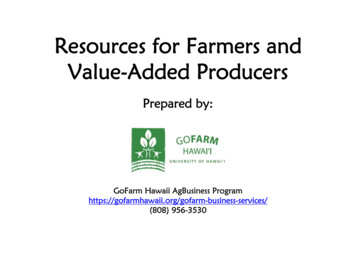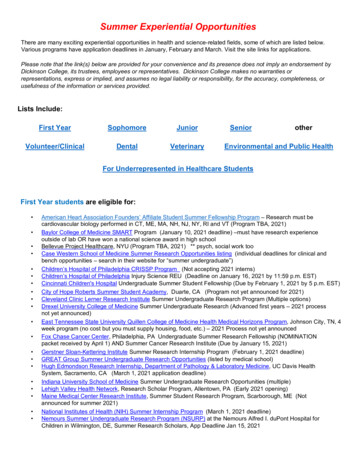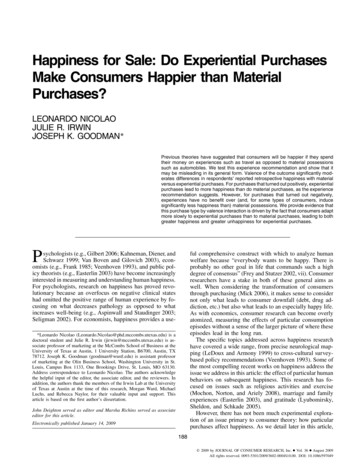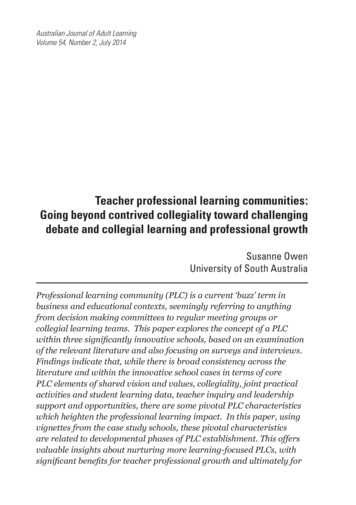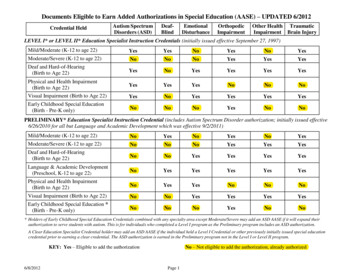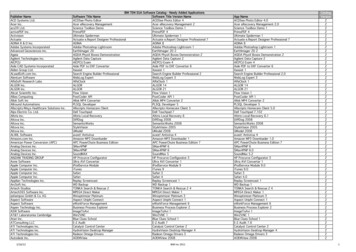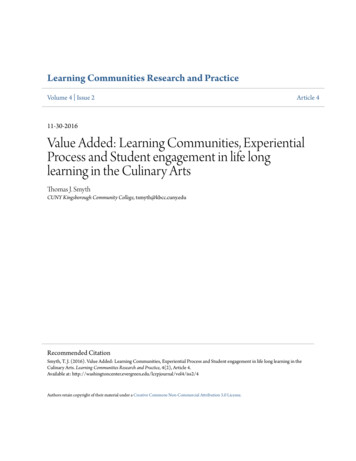
Transcription
Learning Communities Research and PracticeVolume 4 Issue 2Article 411-30-2016Value Added: Learning Communities, ExperientialProcess and Student engagement in life longlearning in the Culinary ArtsThomas J. SmythCUNY Kingsborough Community College, tsmyth@kbcc.cuny.eduRecommended CitationSmyth, T. J. (2016). Value Added: Learning Communities, Experiential Process and Student engagement in life long learning in theCulinary Arts. Learning Communities Research and Practice, 4(2), Article 4.Available at: vol4/iss2/4Authors retain copyright of their material under a Creative Commons Non-Commercial Attribution 3.0 License.
Value Added: Learning Communities, Experiential Process and Studentengagement in life long learning in the Culinary ArtsAbstractCulinary Arts training at the associates level presents a set of challenges to the instructor. It has been myexperience that as the work environment is changing, students face new challenges in the kitchen, including anew mix of skills, both technical and social in nature. In this piece, I reflect on a promising learningcommunity model at our college.KeywordsCTE, Culinary Arts, Stagiaire, Chef, hands-onArticle is available in Learning Communities Research and Practice: vol4/iss2/4
Smyth: Value Added: Learning Communities- life long learning in the Culinary ArtsIntroductionTraditionally, Food Management has been a field practice in CareerTechnical Education (CTE) taught as a stand-alone course, and has astandard element of experiential learning. However, KingsboroughCommunity College (KCC) has created a contextualized curriculum thatlinks Culinary Arts with Spanish 1, offered by two instructors, who alsowork with a third instructor who provides an integrated seminar with anintroduction to Latin American culture and cuisine that reinforces basicSpanish phrases for cooks. This learning community combines theexperiential learning of hands-on cooking with language interactions andcultural diversity that are integral to successful employment, working in aNew York kitchen where Spanish speakers are in the majority.These linked courses employ contextualized theory in a workingkitchen lab with a content-based instruction model of language teaching. Inthis model, students learn safe food handling, culinary concepts, and entrylevel cooking skills while engaging in the experience of bridging thelanguage barriers frequently encountered in the professional kitchen whereSpanish is the primary spoken language. The contextualized instructionprovides theory, demonstration, and modeling of content. The topicscovered in this course include the building blocks of food handling,quantitative measurements, food production, and safety. This matrixprovides students with a highly desirable and marketable skill set. Studentspractice both language and content through visual, auditory, and kinestheticreinforcement.Culturally Responsive Culinary Arts: A Learning CommunityApproachThe learning community model is intended to provide students with asetting that best prepares them for life-long learning and the workforceenvironment (Smith, 1991). This objective is achieved with some specificand very visible structures: Smaller class size Clear identification of the synergy of multiple disciplines toachieve student success Opportunities for students to participate in academic and socialsupport networks A setting for students to acclimate to college life Enhanced student-faculty interaction that aligns more closely withthe College mission1
Learning Communities Research and Practice, Vol. 4 [2016], Iss. 2, Art. 4 Tools to successfully achieve program and course learningoutcomes thereby improving retentionA process for success with administrative oversight to improveretentionWe built our learning community on the theories of Dewey and Kolbthat emphasize reflection, action, and experiential learning, whichsometimes seem at odds with each other but that fuse to create a rich milieuof perspectives (Miettinen, 2000; Kolb & Kolb, 2005). This tension ofperspectives can be seen in a study done by Ronald Hansen (Hansen, 2000)that investigates the circumstance of technology education teachers. In hisstudy, Hansen uncovers the disharmony that exists between scholars andtechnicians-turned-educators. He further investigates what constitutesexperiential learning and concludes that it might in fact hold a morebalanced understanding of how humans learn than other approaches withintechnical education. The common thread that exists among differingperspectives, a key aspect of the educational setting, is that the learner isoperating in an active capacity.Culinary Arts - Training CooksThe transfer of skill and knowledge in the kitchen historically hasrelied heavily on demonstration, rote practice, and experience. Within thechef training tradition, it was customary to identify a mentor/sponsor chefand attach oneself to the guidance and care as an intern at an early age. Thishands-on instruction has been a successful model since cooks first began toorganize the kitchen. Arguably, the French hold the honor of codifying theseprocesses as seen through the works of Auguste Escoffier (Escoffier, 2013)and Caesar Ritz, although the Italians, Chinese, and other highly developedcuisines have representations of their own (Escoffier, 1987).Historically, chefs have managed the tradition of the stagiaire toprovide the experiential learning which shapes the skill, confidence, andsocialization of young cooks needed to be successful in the kitchen (Kaplan,1979). The opportunity to continue in this tradition has fallen short becauseof changing social norms, economics, and worker rights, perceived orimplied. Interesting to note, much of what is described and detailed aboutthe stagiaire experience reflects the processes and outcomes of experientiallearning.Culinary Arts Learning Community: A New journal/vol4/iss2/42
Smyth: Value Added: Learning Communities- life long learning in the Culinary ArtsThe learning community approach to experiential learning views thestudent experience within a larger context and, in doing so, embraces greaterdepth and breadth of chef training, once the brand of the traditionalstagiaire. This integration of hands-on cooking instruction, practical Spanishlanguage applications, and Latin culture is a model that engages the studentin ways that mimic the stagiaire model. The professor’s role is that ofmentor, sponsor, builder of confidence. In this role, the learning is a sharedexperience that bonds not only students to each other but also the instructorto the students.Our experience suggests that students are more engaged in theircoursework and create a bond with each other and with their instructorsthrough this integrative approach to culinary arts. Combing Culinary Artswith Spanish I, and linking those two courses to an integrative seminarfocused on Latin American culture and cuisine, appears to support retention,positive competition, and a climate of shared lifelong learning. From theperspective of chef training, this learning community model provides abuilding block for further developing student chefs.The “chef of the future” will be successful only if educators innovateand plan by looking at the key successes and failures of traditional cheftraining. Educators must consider the road ahead, which includes a rapidlychanging socioeconomic climate filled with innovations in food science andtechnology (Kaplan, 1979). Along with these shifting times come newchallenges and stresses such as food safety and supply chain security.Unlike other profit centers in food businesses, the kitchen and ultimately thechef are drawn into accountability when things go amiss (Cullen, 2012).How we learn to become the cooks of tomorrow is inextricably tied to theexperiences provided in the classroom. Further explorations of learningcommunities in career and technical education, including ones like the onedescribed here, would be of value for educators and for students.3
Learning Communities Research and Practice, Vol. 4 [2016], Iss. 2, Art. 4ReferencesCullen, F. (2012). An Investigation in Culinary Life and Professional Identity inPractice during Internship. Journal of Food Service Business Research.Retrieved e 1005&context tfschcafothEscoffier, A. (2013). A guide to modern cookery. Cambridge University Press.Escoffier, M. R. (1987). The chef in society: Origins and development.Hospitality Review, 5(1), 6.Hansen, R. E. (2000). The Role of Experience in Learning: Giving Meaning andAuthenticity to the Learning Process in Schools. Journal of TechnologyEducation, 11(2), 23-32.Kaplan, P. W. (1979). A Happier Life Through Television. Film Comment, 15(4),49.Kolb, A. Y., & Kolb, D. A. (2005). Learning styles and learning spaces:Enhancing experiential learning in higher education. Academy ofmanagement learning & education, 4(2), 193-212.Miettinen, R. (2000). The concept of experiential learning and John Dewey'stheory of reflective thought and action. International Journal of LifelongEducation, 19(1), 54-72.Smith, B. L. (1991). Taking Structure Seriously: The Learning CommunityModel. Liberal Education, 77(2), urnal/vol4/iss2/44
learning in the Culinary Arts Thomas J. Smyth CUNY Kingsborough Community College, tsmyth@kbcc.cuny.edu Authors retain copyright of their material under aCreative Commons Non-Commercial Attributi

